Lebanese Stuffed Kousa Squash
Jul 27, 2011, Updated May 12, 2024
This post may contain affiliate links. Please read our disclosure policy.
Lebanese Stuffed Kousa Squash (koosa) is a traditional dish of summer squash stuffed with a meat and rice mixture, cooked in tomato broth. Find out what “are you a koosa” means in my original post story through the button above; many comments in the section below this recipe post are about this original favorite story!
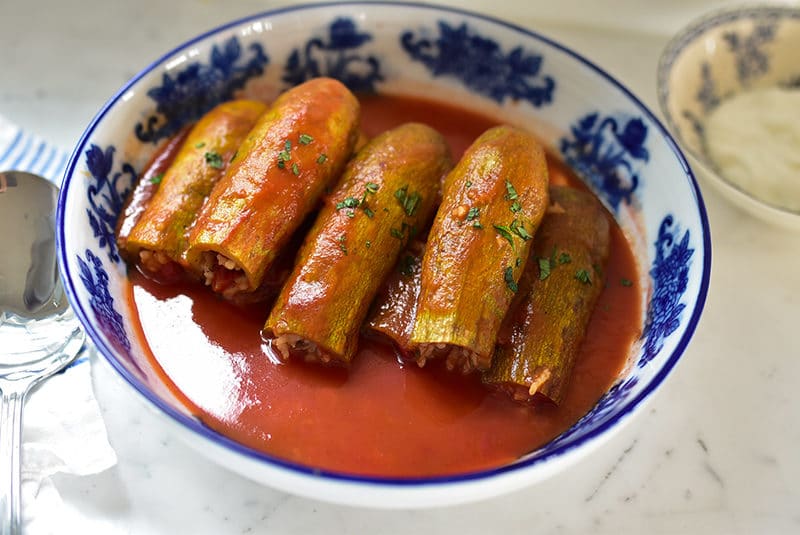
Ohhh the heaven that is our beloved Lebanese stuffed squash. This is the dish we take ultimate comfort in for the tender summer squash filled with a seasoned meat and rice mixture, simmered in a deeply savory tomato broth. One of my favorite stories that I originally published about kousa (I’m a kousa, are you?!) is here.
Table of Contents
- Watch my video tutorial for how to make kousa (koosa)!
- What is kousa?
- Why you’ll love stuffed kousa
- Ingredients for stuffed kousa
- How to make authentic Lebanese stuffed kousa
- How to serve Stuffed Kousa
- Tips and Variations
- Frequently Asked Questions
- More Recipes for Kousa
- Lebanese Stuffed Kousa Recipe Recipe
Watch my video tutorial for how to make kousa (koosa)!
What is kousa?
Kousa is the Arabic word for squash or zucchini, often also referred to as Mexican squash, and gray squash. Their short and somewhat wide shape makes them perfect for stuffing with a ground beef and rice mixture, then boiled in tomato sauce or tomato broth, and thus, kousa mahshi!
You will see “kousa” spelled a variety of ways: kousa, koosa, coosa, cousa, kusa, and no doubt other spellings beyond these! I have used them all…
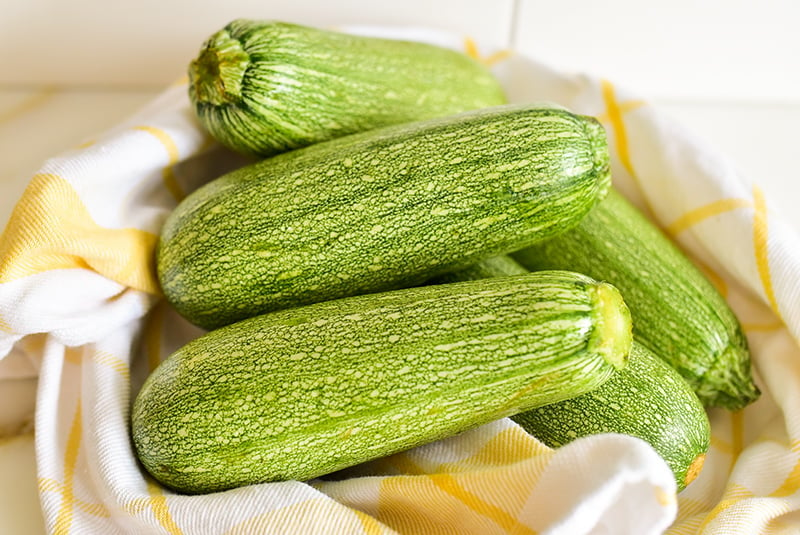
Why you’ll love stuffed kousa
This Lebanese kousa recipe is a traditional dish of light green summer squash, stuffed with a meat and rice mixture, cooked in a deeply savory tomato broth. Kousa mishi is a true hallmark recipe of most every Lebanese family.
Ingredients for stuffed kousa
Koosa. Small lebanese zucchini, or yellow squash, washed, trimmed, and cored.
Ground beef. Use any type of lean ground meat, I like ground chuck or lamb!
Rice. Medium grain for the rice stuffing. Long grain rice or short grain rice both work – any white rice – if that’s what you have on hand!
Salt and pepper. Kosher salt and black pepper to taste!
Cinnamon. Ground cinnamon is a crucial flavor in Lebanese cuisine, it’s a great way to add depth of flavor.
Tomato puree. Tomato puree, tomato sauce, tomato juice, add tomato paste, etc. Any variation of creating a delicious, rich tomato broth for the kousa!
Garlic. 6-8 cloves of garlic will do the job for flavoring the broth, simply tucked in among the squash.
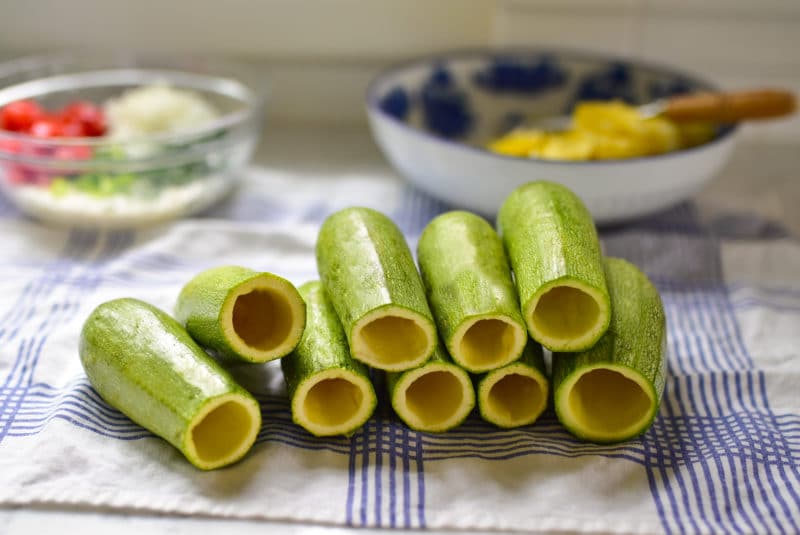
How to make authentic Lebanese stuffed kousa
Step 1: Core the squash. First, cut off the stalk end and dried tips, taking care not to cut off too much of the zucchini flesh. I’ve found that the best way to hollow the kousa is to use a special tool: zucchini corer, apple corer, or paring knife are different kinds of tools that would work perfectly for accomplishing cored zucchini.
Watch up close how to core koosa here:
Step 2: Make the filling. In a large mixing bowl, combine the meat, rice, salt, pepper, and cinnamon.
Step 3: Fill the squash. Make sure you fill the lebanese squash loosely. Since it’s uncooked rice in the meat mixture, it needs room to expand. Cousa squash should only be filled ¾ of the way full, not packed in. If using small zucchini, use even less filling.
Step 4: Cook the stuffed kousa in tomato broth. Put tomato sauce or tomato puree in a deep pot, season with salt and pepper, dispersing the garlic cloves throughout. Make sure the stuffed end is up, but that the stuffed kousa is tilted so that you don’t need as much liquid to cover them. Cover the pot and bring to a boil over medium heat. Then, reduce to low heat and simmer for about an hour.
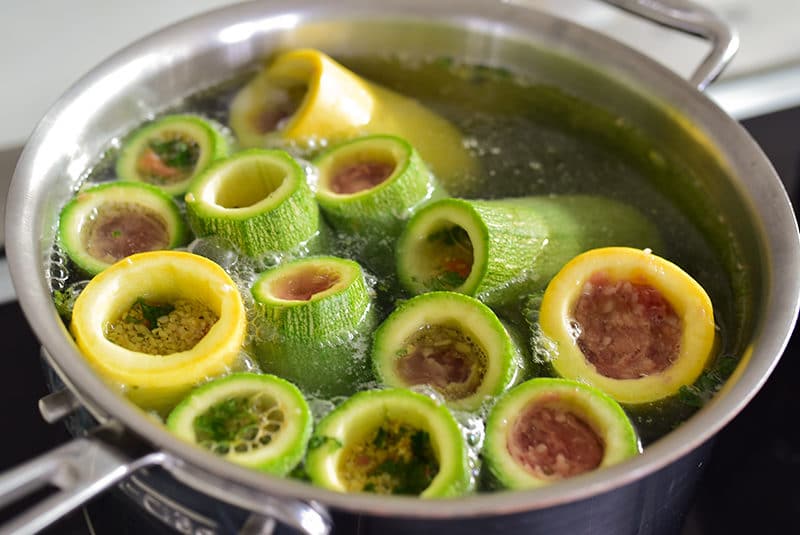
How to serve Stuffed Kousa
In a bowl to contain the juices, cut open the length of the kousa and ladle the broth over top. Add a spoonful of labneh (yogurt sauce), drizzle of olive oil, and/or chopped herbs (parsley or mint). If you don’t have fresh herbs on hand, a squeeze of lemon juice will give this delicious meal some zest.
Serve with pita or flatbread, or side-by-side with some of my favorite middle eastern dishes; Lebanese Fattoush salad, Lebanese Tabbouleh Salad, or Lebanese Salad (salata)!
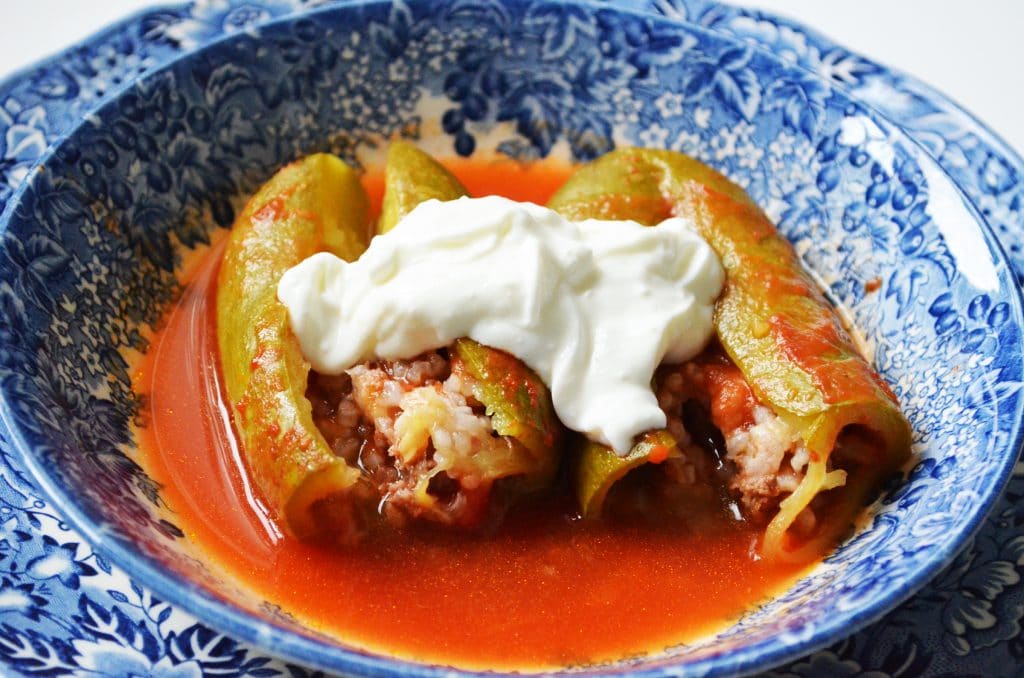
Tips and Variations
- Be sure not to overstuff the kousa or pack them too tightly.
- Take care not to puncture the kousa when coring, using a paring knife after the initial coring will help with this.
- Put a plate on top to hold the kousa in place while cooking, exactly like when making grape leaves!
- Can use zucchini yellow or green or combination of the two.
- For a crunch element, half a cup pine nuts can be sprinkled over top of the final product.
- You can make a vegetarian filling instead of this meat version; see my recipe for Vegetarian Stuffed Kousa. Try minced bell peppers in the mix!
- If you’re looking for an alternative to the tomato broth, cooking in yogurt broth or chicken stock. This is called kousa in yogurt sauce, or kousa bil laban.
- Use the zucchini cores for other zucchini recipes like zucchini bread, as a koosa core saute, or with eggs to make zucchini fritters (ijjeh).
- Add fresh herbs, I like fresh parsley for its bright flavor.
Frequently Asked Questions
You can find this kind of squash at your local grocery store or farmer’s market!
Some people core and then freeze the kousa before stuffing and cooking them. They do get soft when frozen so it is better to make them from fresh, room temperature squash.
A special kousa corer is best because it’s narrow enough to get into small squash. Apple corer also works and so does zucchini corer, just select bigger kousa for these.
Yes and no! Kousa is the Arabic word for squash, of which there are many variations. Mexican zucchini, white squash, grey squash, are all an alternative type of zucchini appropriate for this popular Middle Eastern dish. Typically kousa refers to small light green squash.
Absolutely. Check out my Vegetarian Stuffed Koosa recipe. This filling uses bulgur and lots of fresh herbs, tomatoes, and spices. Chickpeas are also delicious in vegetarian koosa.
Yes, it’s even better the longer it sits, and can be stored in an airtight container, or the pot it is made in for easy reheating, in the refrigerator for a couple days.
Yes! Try using baby eggplants instead of zucchini, or something as simple as white pepper instead of black pepper for a slight variation in flavor, as well as different cooking methods. You can use a pressure cooker or dutch oven over medium-high heat instead of a large pot.
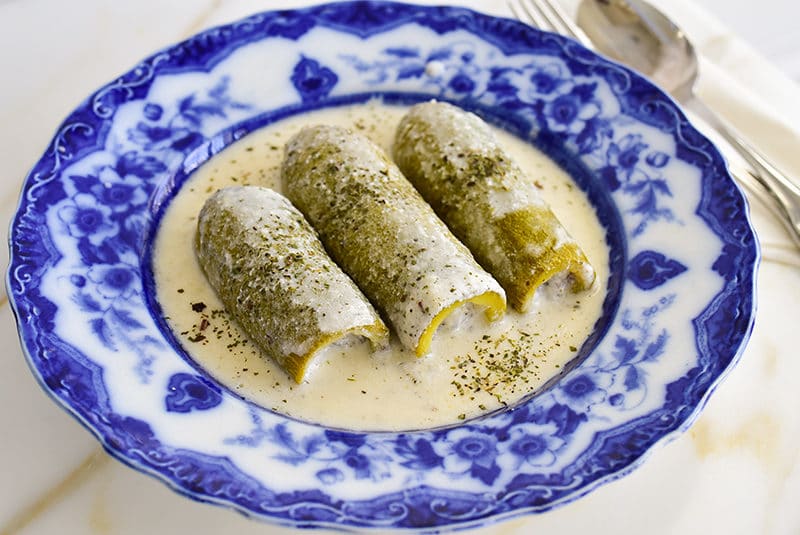
More Recipes for Kousa
Lebanese Kousa Soup with Meatballs
Vegetarian Stuffed Koosa Squash
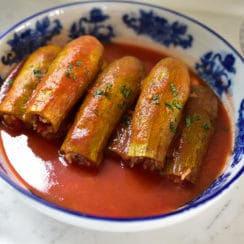
Lebanese Stuffed Kousa Recipe
Ingredients
- 12-18 kousa, small zucchini, and/or yellow squash, washed, trimmed and cored
- 1/2 pound ground beef chuck or lamb
- 1/2 cup medium-grain rice, rinsed
- 1/2 teaspoon kosher salt
- Few grinds black pepper
- 1/2 teaspoon ground cinnamon
- 1 28 oz. can tomato puree, sauce, or juice
- 6-8 cloves garlic, trimmed, peeled and halved
Instructions
- Use your hands to combine the meat, rice, salt, pepper and cinnamon.
- Loosely fill each squash with the stuffing. Loosely is the key word here, because the rice does not liketo be crowded. It needs room to expand, so fill only about ¾ of the kousa with stuffing, and don’t pack it in. You may have leftover stuffing that you can form into meatballs to be cooked with the kousa.
- In a bowl, season the tomato puree or sauce with ½ teaspoon salt and pepper. Place the kousa (stuffed end up but tilted so that you don’t need as much liquid to cover them) in a tall pot with the garlic cloves interspersed and the meatballs on top.
- Pour the tomato puree over all. Pour water over that until the kousa and meatballs are just covered (some can stick out a bit above the liquid). Cover the pot and bring the liquid to a boil over medium heat. Reduce the heat and simmer until the squash is tender and the meat is cooked through, about an hour. It's fine to continue to cook at a low temperature for up to 2 hours.
- Remove the kousa to a serving bowl and taste the sauce. Adjust seasonings, adding salt and pepper as needed. Serve the kousa in individual bowls or on plates with the sauce spooned over it. You can also make a cut down one side of the kousa with the side of a spoon and ladle the sauce over that, to whet the whistle of the stuffing.
Video
Nutrition
Nutrition information is automatically calculated, so should only be used as an approximation.

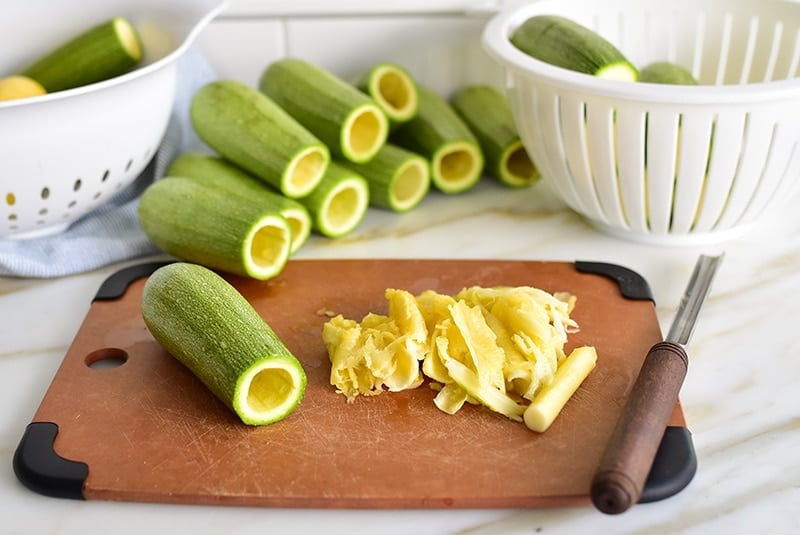
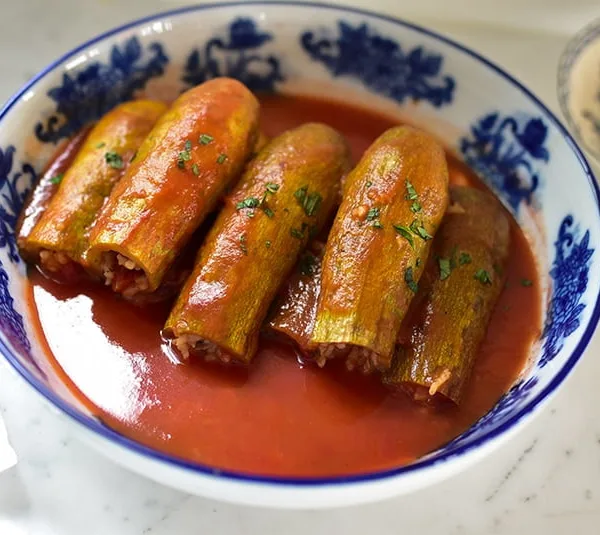
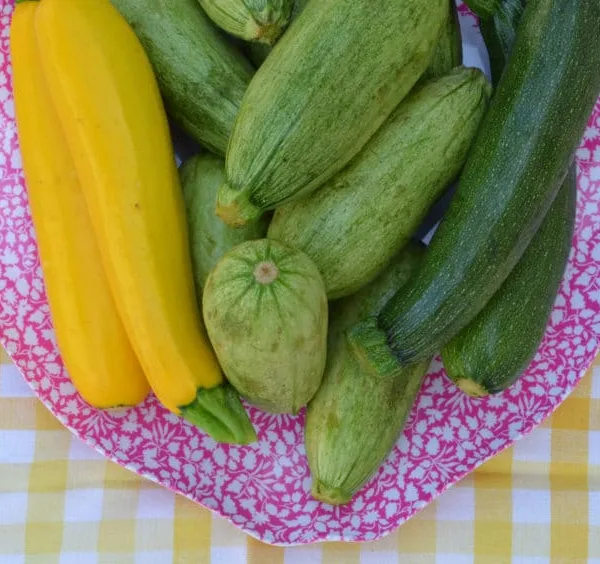
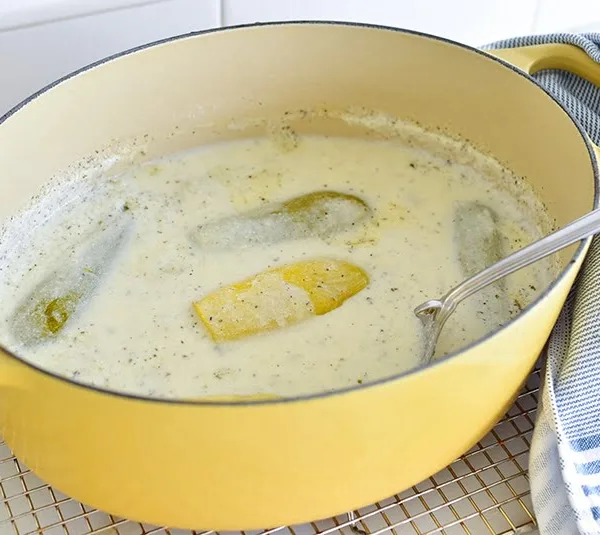







Love this recipe!!!!
So delicious, thank you Terry!
Why don’t you use 7 spice??
That is delicious here no doubt! It’s a family thing really…my mother used cinnamon and so I do too, but I do find myself adding in 7 spice to many dishes like hushweh and kibbeh too.
Thank you for these delicious recipes. It was difficult to find this type of recipe and the yogurt mint recipe.
I love having this recipe available too, so helpful and not so easy to find. Thank you Nan!
Can you use koosa to bake in a bread somewhat like zucchini bread?
Great thought, absolutely can do that, same as zucchini!
Hi Maureen, thanks for sharing your recipe. I just visited my mother on Prince Edward Island (on the east coast of Canada) and she made coosa. Growing up, my favourite way to have it was always with the “pickled” coosa that Roger Toomey mentions in his comment. They had a certain crunchiness to them that the fresh ones didn’t have. So delicious! I’ve been trying to find something online that would explain how to salt them and store them but have had no luck. My mother says she just cored them, filled them with pickling salt, and placed them in a large glass jar but the last time she did it (many years ago), they spoiled. Have you ever preserved them this way? Do you have any suggestions for how to do it? Thank you!
Sue I love all of this! I have not done the pickled koosaa. I believe you could do same as pickles of any sort with brine, either canned or quick pickle for fridge, but adding a grapeleaf to the jar will aid in the crunch factor.
I make a variation of koosa, I call it inside out or lazy coosa. I’m not great at coring squash, so I slice it super thin with a mandolin and layer it with the meat (lamb) and tomato mixture and pine nuts (lasagna style). I bake it and my entire family loves it! My daughter’s are now making it for their family. (I bought them your cookbook) Also, my family uses allspice instead of cinnamon, but my brother in law’s family only used cinnamon. Each to his own. Love your blog!
“Keefek”Maureen ~
Reading these is like having my Nana back with my family! She was from a farm town near Beirut(Housh Barada)
I live in Portland Maine and growing up, she lived in an apartment above us. I learned to make Taboulleh, Kibbe, KOOSA, Labneh, Hummus, and all things Lebanese.
Such wonderful memories.
I understand that your Mom has passed away. It’s hard to lose a parent. HUGS
My Mom and now I have continued making these meals along with other cuisines and of course regular old American dishes.
Jean, thank you for the hugs, the history, and sharing! Special special note and how lovely you have learned so much joy.
Thank you for the recipe. I just made it for second time. You are right, the flavors only get better the next day. I changed one thing, I puréed the cored out innards of cousa and added it to tomato sauce instead of water. It is water and fiber. Thanks again for a new comfort food dish!
Great idea Chris, thank you!
Thanks for putting this recipe out there. I make Koosa 3 or 4 times a year and I will make a point of using cinnamon. I have always used Allspice for this dish. It’s a great comfort food. And yes, I’m a Koosa!
I bet you are indeed a koosa!!!
This was a huge success! Coosa makes me think of my great-grandmother, and it made me really happy to make this. I definitely recommend letting it sit overnight to let all the flavors soak in. Thank you for sharing your recipes!
Hurray! Thank you Rosine! Agreed, day 2 is sooo good, if you can wait that long (or have any left over!).
Maureen, love the recipe. In Honduras there is a very large Palestinian population going back to ends of 1800’s. There they call this dish “Pipianes” and they’re fabulous!
Thank you!
Interesting! Thanks for sharing!
My mother passed away in December. Your blog makes me feel close to her as I read through all the recipes she made me. Thank you….
Rest her soul Tina. I’m honored to know my work can give you some comfort and connection with your mama.
Hi Maureen, do you ever put lemon juice in the sauce?
Have not done that but it sounds like a great way to add more of the tang I love!
Wonderful story! My mom picked over 6 dozen koose/cousa/coosa 2 weeks ago and we had our first batch of the summer. Soooooo good!! Thanks for writing down the recipe.
Lucky you!!! They’ll be delicious!
My mom made this, she would save the insides of the squash you removed when making the coosa and mix it with eggs for breakfast. I think she called it fud-a-key.
Do you know a recipe for that?
Yes Mike! That recipe is in my cookbook, but I’ll put it on my list for the blog too. My mom calls it “ijeh” but fudakeh also sounds familiar.
So much like my friends’ Lebanese mothers’ version! The only difference being, they added 1/2 tsp. allspice and 1/8 tsp cinnamon to the meat mixture, a little lemon juice and a tsp or two of pomegranate molasses to the tomato sauce. Unfortunately, the moms passed away before I could get the full recipe. My problem has also been the rice to meat ratio, and what kind of rice to use. Every “authentic” recipe seems to vary re: how much rice to meat. Some call for as little as 1/2 cup uncooked rice to 1 lb meat, others as much as 1 1/2 cups rice to 1 lb meat! As for the rice, some recipes calls for short grain, others medium, and some long grain; some specifying uncooked rice, others par cooked, some soak the rice for an hour before combining with the meat! Ugh! My first try, years ago, was a disaster. I used uncooked short grain rice and even after even an hour of cooking, the rice was still “hard.” (I didn’t over-pack and the sauce covered the coosas!) Any suggestions? Thanks! (Love your site and recipes!)
Thanks for this! I think the ratio is a matter of preference, and so too with the rice. I have taken to using medium grain rice and like how it comes out very much with a 1-1 ratio, so 1 cup of rice to 1 cup of meat. Hope you’ll make it and enjoy! I’m going to try your pomegranate molasses idea in the sauce–sounds so good.
Hello Maureen,
Thanks for this recipe! Very great!
Hi Maureen! I’m loving your cookbook! My Syrian-heritage (great-grandparents “came over on the boat”) husband says I’ve been converted! I was wondering, with this dish specifically, is it possible to core and stuff the squash a day ahead and put it in the fridge until time to cook? I wasn’t sure if the cored squash would “wilt” or if the rice would absorb too much moisture from the meat. Thank you for sharing your recipes!
I have frozen it this way but haven’t refrigerated–I suspect it will be just fine! Thanks so much Lisa!
I make a similar recipe using eggplant. Luckily I have a Lebanese grocery nearby and find lots of interesting ingredients. I’ll definitely give your recipe a try. Love Lebanese food.
Great Linda, thank you!
I don’t eat beef or lamb, any suggestions how to make this vegetarian? Thank you.
Hi Edith–you can use the filling for my vegetarian grape leaves, recipe is here, but also my upcoming cookbook has other vegetarian stuffing recipes I think you’ll love!
I wish I knew what happened to the corer either my Grandmother or Mother used. I’ll bet my Grandmother’s cored several tons or more of coosee (as we pronounced it) and my Mother’s did a bunch. The corers were almost impossible to buy and they were a prized kitchen possession. Over the winter my Mom’s would get lost in a drawer and when Dad brought in the first coosee of the season all of the kitchen drawers go cleaned until it was found. Actually Mom didn’t use it so much. She would say “I’ll cook it but anyone who wants it will have to core it.” So Dad would set down at the kitchen table with a bucket of squash at one side and a bucket of innards between his legs and core every one. Whatever we couldn’t eat fresh was originally salted and put in a crock in the cellar but later frozen. So we had coosee all winter.
Your recipe is very close to what we had except for the garlic. Mom wasn’t much into garlic. However one of my Aunts loved garlic and it was in everything she made. The other thing is Mom used a pressure cooker rather than open pot. I don’t know if this did anything other than make it faster.
Stuffing is great if one has the time and wants a good looking presentation for guests, but having been a bachelor a long time, I just cube the squash, sliver the cabbage, or whatever to anything else that would be traditionally stuffed and add the rice, meat, etc. After cooking it doesn’t look the greatest but tastes the same and saves lots of time.
Hi Maureen,
I feel so lucky to have found your website. I really love it! Lebanese food is my absolute favorite and has been for over 20 years since my daughter married into your culture. She is a fabulous cook and many ( even Lebanese) have asked her why she doesn’t do catering. She is very artistic and so her food is always presented beautifully. She is in Beruit right now visiting the Tanoukhi family. She cooks very much like you do ,which is another reason I love your site. Btw, I made some kale chips the other day using zataar. They turned out fabulous!! I’m in Georgia, my Julie is in Youngstown and you are way up in Michigan so the chances of meeting are slim. Just thinking about this wonderful food, though, brings both of you to mind.
Karen, how very special. I would love to meet you all…come on up north! I have relatives in Youngstown, the Shakers. What a great trip your daughter must be having right now, and how jealous I am! Please give her my warm regards, and the same to you.
Love stuffed coosa… This year I grew white coosa. My plant center called them Lebanese squash. I was so excited to find them. My Uncle Lucas grew these for the family years ago when he still raised a huge garden. I follow the same basic recipe you have and I also add some pine nuts. Thank you for all your great recipes.
Hi Maureen, Just made stuffed peppers — a Bosnian/Croatian standard — for my husband Alija. The recipe is very similar to yours, including the secret of cinnamon in the meat. Of course, I must add Vegeta as well (because no modern Balkan dish is complete without it)–but I use it very sparingly. The peppers were pale green, fresh picked from an Indiana garden, and I made the sauce from fresh picked tomatoes. The peppers were stuffed with cooked ground beef (sauteed with onions and garlic) and wild and long grain rice. Yummy. You’re right about them tasting even better the next day. It’s great to have leftovers the family will love.
Hi Patrice! Your peppers sound divine, love the wild rice mixed in, and I’m curious about the Vegeta…I will try it sometime.
Hello Sweet Cousin, your dad, would have been my Uncle “Coosa”. Absolutely, tender, sweet and filled with rare ingredients. Memories of him bring a smile to my face, ache in my heart, and yearning to be in his presence again. What laughter, I can still hear his chuckle!!! Love you all.
Meg, I’ve just read your beautiful note to my mother. You’ve brought us both to tears. We love you.
I am so very happy to learn that the unusual languages that fathers speak to their daughters live on in fond memories. The father that invents a special form of speak for his daughter truly loves her, Director, or otherwise. For a Pop, speaking Coosa is the gateway back to childhood itself.
Your girls will always love their father’s unusual language.
Your dad sounds so Lebanese and I so enjoyed that story! Of course, my kids cringe (son especially) at any display of even the most discrete affection in public. Oh well. Great post.
Joumana, I would love to hear more about your family sometime…
A lovely story! And I love your vibrant photos too!
Maureen, this dish looks fabulous…comfort food at it’s best! The story of your dad is so heartwarming. I am sure he is missed greatly by many.
Thank you Maria–comfort food is a great description for this dish!
Hi Maureen,I love Lebanese food as both of my grown children have a lebanese father and had their sity and jito until they passed away,they always want me to make kibbee naya but I forgot how many times my mother in law had put the meat through the grinder so it’s fine enough.I make my own hummus and tabouli still and lost my lebanese cookbook that we bought from Our Lady of Lebanon in Waterbury/Prospect Connecticut,if you know where I can find a cookbook and where to get the meat ground I would be ever so grateful and so would my kids.Thanks and can’t wait for some local squash to make Coosa Mehshee !!!
Hi Susan–a lot of the churches have done those great cookbooks and they go out of print. You will find all of the info you’re looking for in MY cookbook though! It’s coming out next spring. See my post here about how to grind the kibbeh meat.
Hi Susan, I know this is an old post that you probably won’t see, but I just had to comment that I had many close relatives in Waterbury Connecticut. I’m sure we’re not related but I bet we know some of the same people. Anyway I just got excited when I saw Waterbury mentioned, because there is such a large Lebanese population there.